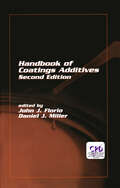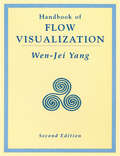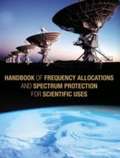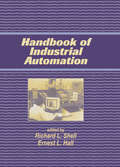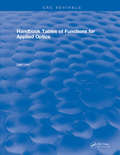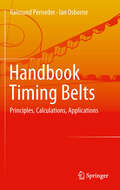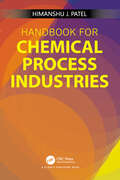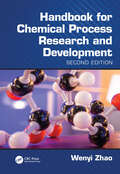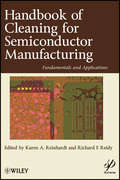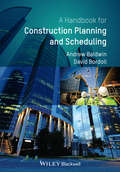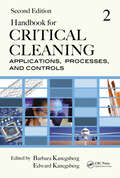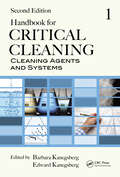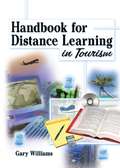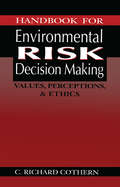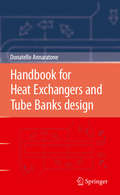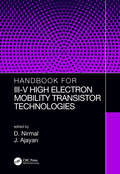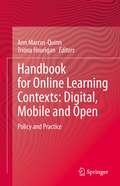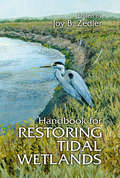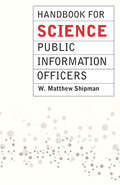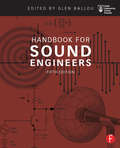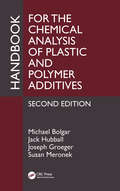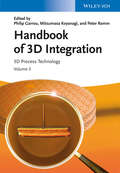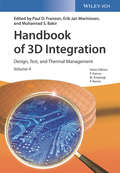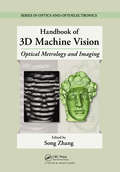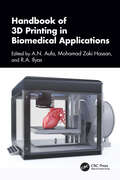- Table View
- List View
Handbook Of Coating Additives
by John J. Florio Daniel J. MillerThis volume compiles a wealth of information on the composition, properties, utilization, and performance of major classes of additives while alerting formulators to potentially damaging interactions and challenges in the selection and testing of these materials. Completely revised and updated, the Handbook of Coatings Additives, Second Edition off
Handbook Of Flow Visualization
by Wen Jei YangWith contributions from some of the world's leading experts, the second edition of this classic reference compiles all major techniques of flow visualization and demonstrates their applications in all fields of science and technology. A new chapter has been added that covers flow visualization applications in large wide tunnels for airplane and automobile testing. Several important examples of applications are included. A second new chapter details the use of infrared (IR) cameras for detecting and observing the boundary layer transition in industrial wind tunnels and flight testing of commercial transport airplanes. A final new chapter has been added on multiphase flow and pulsed-light velocimetry.
Handbook Of Frequency Allocations And Spectrum Protection For Scientific Uses
by National Research Council of the National AcademiesThe electromagnetic spectrum is a vital part of our environment. Information encoded in the spectrum of radiation arriving at earth from the universe is the means by which we learn about its workings and origin. Radiation collected from the Earth’s land, oceans, biosphere, and atmosphere provide us with much of the data needed to better understand this environment. Wise use of the spectrum is necessary if we are to continue these advances in scientific understanding. To help guide this effort, the NSF and NASA asked the NRC to develop a set of principles for fostering effective allocation and protection of spectral bands for scientific research. This handbook contains practical information in this connection including a description of regulatory bodies and issues, a discussion of the relevant scientific background, a list of science spectrum allocations in the United States, and an analysis of spectrum protection issues.
Handbook Of Industrial Automation
by Richard ShellSupplies the most essential concepts and methods necessary to capitalize on the innovations of industrial automation, including mathematical fundamentals, ergonometrics, industrial robotics, government safety regulations, and economic analyses.
Handbook Tables of Functions for Applied Optics
by 0 Levi. LIn most cases, values are tabulated in the customary manner- ten on a line. In some tables, the second column gives the first few places which apply to all the entries in that row. When an entry has a bar placed over it, the value heading the next row should be applied. The tables computed on a digital electronic computer which works with an accuracy of at least seven significant places. In some case, e.g. when very large exponents occurred in the computation, computation at double this precision was used.
Handbook Timing Belts
by Ian Osborne Raimund PernederTiming belts offer a broad range of innovative drivetrain solutions; they allow low-backlash operation in robot systems, they are widely used in automated processes and industrial handling involving highly dynamic start-up loads, they are low-maintenance solutions for continuous operation applications, and they can guarantee exact positioning at high operating speeds. Based on his years of professional experience, the author has developed concise guidelines for the dimensioning of timing belt drives and presents proven examples from the fields of power transmission, transport and linear transfer technology. He offers definitive support for dealing with and compensating for adverse operating conditions and belt damage, as well as advice on drive optimization and guidelines for the design of drivetrain details and supporting systems. All market-standard timing belts are listed as brand neutral. Readers will discover an extensive bibliography with information on the various manufacturers and their websites. This practical handbook addresses both the needs of application engineers working in design, development and machine-building, and is well-suited as a textbook for students at universities and vocational schools alike.
Handbook for Chemical Process Industries
by Himanshu J PatelChemical processing industry plays a pivotal role in the economy of a country, as chemicals are required in every sphere of our lives. This book covers chemical processing of dyes, pigments, drugs and pharmaceutical products, fermented products, agrochemicals, explosives, polymers, Period II and III chemicals, chemicals, sugar, coatings, starches, soaps and detergents, paper, pulp, glass, and cement. It includes sources of natural materials, collection process, purification, and extraction of different chemicals from natural materials like petroleum, coal and ores from the Earth. It includes manufacturing details of C1 to C4 and aromatic compounds obtained from natural materials. The book covers both traditional and modern sectors of the chemical processing industry. It provides knowledge on the properties of the chemical and manufacturing process (such as raw materials, chemical reactions, quantitative requirement, flow sheet diagram, procedure) and its uses. The book is based on the author's expertise and has been developed with an awareness of the quantitative requirement for manufacturing chemicals. Data has been collected from industry, thus it will be useful to industry personnel, research groups, academicians and institutional organizations.
Handbook for Chemical Process Research and Development, Second Edition
by Wenyi ZhaoThis fully updated second edition reflects the significant changes in process chemistry since the first edition and includes more common process issues such as safety, cost, robustness, and environmental impact. Some areas have made notable progress such as process safety, stereochemistry, new reagents and reagent surrogates. Forty years ago there were few process research and development activities in the pharmaceutical industry, partly due to the simplicity of drug molecules. With increasing structural complexity especially the introduction of chiral centers into drug molecules and stricter regulations, process R&D has become one of the critical departments for pharmaceutical companies. Features: This unique volume now in its second edition is designed to provide readers with an unprecedented strategy and approach which will help chemists and graduate students develop chemical processes in an efficient manner. Promotes an industrial mindset concerning safety and commercial viability when developing methods. The author discusses development strategies with case studies and experimental procedures. Focuses on mechanism-guided process development which provides readers with practical strategies and approaches. Addresses more common process issues such as safety, cost, robustness, and environmental impact. This book provides a new direction for scientists, researchers, and students in materials science and polymer chemistry who seek to better understand the chemistry behind conducting polymers and improve their performance for use in advanced energy applications.
Handbook for Cleaning for Semiconductor Manufacturing: Fundamentals and Applications (Wiley-Scrivener #67)
by Richard F. Reidy Karen A. ReinhardtThis comprehensive volume provides an in-depth discussion of the fundamentals of cleaning and surface conditioning of semiconductor applications such as high-k/metal gate cleaning, copper/low-k cleaning, high dose implant stripping, and silicon and SiGe passivation. The theory and fundamental physics associated with wet etching and wet cleaning is reviewed, plus the surface and colloidal aspects of wet processing. Formulation development practices and methodology are presented along with the applications for preventing copper corrosion, cleaning aluminum lines, and other sensitive layers. This is a must-have reference for any engineer or manager associated with using or supplying cleaning and contamination free technologies for semiconductor manufacturing. From the Reviews... "This handbook will be a valuable resource for many academic libraries. Many engineering librarians who work with a variety of programs (including, but not limited to Materials Engineering) should include this work in their collection. My recommendation is to add this work to any collection that serves a campus with a materials/manufacturing/electrical/computer engineering programs and campuses with departments of physics and/or chemistry with large graduate-level enrollment." —Randy Wallace, Department Head, Discovery Park Library, University of North Texas
Handbook for Construction Planning and Scheduling
by Andrew Baldwin David BordoliThe authoritative industry guide on good practice for planning and scheduling in construction This handbook acts as a guide to good practice, a text to accompany learning and a reference document for those needing information on background, best practice, and methods for practical application. A Handbook for Construction Planning & Scheduling presents the key issues of planning and programming in scheduling in a clear, concise and practical way. The book divides into four main sections: Planning and Scheduling within the Construction Context; Planning and Scheduling Techniques and Practices; Planning and Scheduling Methods; Delay and Forensic Analysis. The authors include both basic concepts and updates on current topics demanding close attention from the construction industry, including planning for sustainability, waste, health and safety and Building Information Modelling (BIM). The book is especially useful for early career practitioners - engineers, quantity surveyors, construction managers, project managers - who may already have a basic grounding in civil engineering, building and general construction but lack extensive planning and scheduling experience. Students will find the website helpful with worked examples of the methods and calculations for typical construction projects plus other directed learning material. This authoritative industry guide on good practice for planning and scheduling in construction is written in a direct, informative style with a clear presentation enabling easy access of the relevant information with a companion website providing additional resources and learning support material. the authoritative industry guide on construction planning and scheduling direct informative writing style and clear presentation enables easy access of the relevant information companion website provides additional learning material.
Handbook for Critical Cleaning: Applications, Processes, and Controls, Second Edition
by Barbara Kanegsberg Edward KanegsbergApplications, Processes, and Controls is the second volume in the Handbook for Critical Cleaning, Second Edition.Should you clean your product during manufacturing? If so, when and how? Cleaning is essential for proper performance, optimal quality, and increased sales. Inadequate cleaning of product elements can lead to catastrophic failure of the
Handbook for Critical Cleaning: Cleaning Agents and Systems, Second Edition
by Barbara Kanegsberg Edward KanegsbergCleaning Agents and Systems is the first volume in the Handbook for Critical Cleaning, Second Edition.Should you clean your product during manufacturing? If so, when and how? Cleaning is essential for proper performance, optimal quality, and increased sales. Inadequate cleaning of product elements can lead to catastrophic failure of the entire syst
Handbook for Distance Learning in Tourism
by Kaye Sung ChonDeliver quality instruction to your students-on-campus or offThe Handbook for Distance Learning in Tourism is a practical, down-to-earth guide to developing and using print-based and Internet-based flexible learning resources for courses where students rarely, if ever, attend on-campus classes. Whether you&’re a teacher who needs to develop course notes into a flexible learning package, a Web site, or both, or you just want information about how to teach in a flexible environment, the book will provide the help you need-in language you can understand. Designed to guide you through the completion of a project-or a semester-this hands-on book offers strategies, suggestions, hints, and examples, and includes a hotel and tourism case study that illustrates effective concepts and strategies.Written by Gary Williams, co-editor of The Internet and Travel and Tourism Education (Haworth), this unique book will help you develop print-based and Internet-based learning resources instead of focusing only on one or the other, breaking down the barriers placed between learning environments. The strategies presented are timeless, with no comparisons of specific commercial or noncommercial products to become outdated and no Web site addresses to become useless. The book makes extensive use of tables, graphics, and illustrations and has its own Web site that&’s regularly updated, listing online resources arranged on a chapter-by-chapter basis.The Handbook for Distance Learning in Tourism examines: the roles and characteristics of a project manager developing and buying resources considerations before committing to a project maximizing project ownership ensuring quality content educational design guidelines media foundations production, design, and maintenance of print resources developing and using Web sites computer-mediated contact course management systems (CMS) and much more!The Handbook for Distance Learning in Tourism is an invaluable guidebook for educators working in the field of hotel and tourism management as well as academics, project managers, and educational designers who are interested in flexible learning developments.
Handbook for Environmental Risk Decision Making: Values, Perceptions, and Ethics
by C. Richard CothernThis handbook describes the broad aspects of risk management involving scientific policy judgment, uncertainty analysis, perception considerations, statistical insights, and strategic thinking. This book presents all the important concepts to enable the reader to "see the big picture." This ability is extremely important - it allows the decision ma
Handbook for Heat Exchangers and Tube Banks design
by Donatello AnnaratoneWhen a heating fluid transfers heat to a heated fluid through a wall, if the fluids are in parallel flow or counter flow it is possible to compute exactly both the transferred heat and the temperatures of the fluids via well-known equations. This holds true both for design and verification computation. However, the motion of the fluids is never in parallel flow or counter flow in heat exchangers and in tube banks. Instead, it is rather complex and consists of a combination of various cross flows. Hence, a precise design of the above components requires, on a case-by-case basis, the availability of the value of certain crucial factors or of corrective factors so as to make it possible to use the equations relative to parallel flow or counter flow. This handbook contains the introduction to the problem, its design criteria, and about 70 tables for the exact design and verification computation. It also indicates how to proceed in the case of cross flow.
Handbook for III-V High Electron Mobility Transistor Technologies
by D. Nirmal J. AjayanThis book focusses on III-V high electron mobility transistors (HEMTs) including basic physics, material used, fabrications details, modeling, simulation, and other important aspects. It initiates by describing principle of operation, material systems and material technologies followed by description of the structure, I-V characteristics, modeling of DC and RF parameters of AlGaN/GaN HEMTs. The book also provides information about source/drain engineering, gate engineering and channel engineering techniques used to improve the DC-RF and breakdown performance of HEMTs. Finally, the book also highlights the importance of metal oxide semiconductor high electron mobility transistors (MOS-HEMT). Key Features Combines III-As/P/N HEMTs with reliability and current status in single volume Includes AC/DC modelling and (sub)millimeter wave devices with reliability analysis Covers all theoretical and experimental aspects of HEMTs Discusses AlGaN/GaN transistors Presents DC, RF and breakdown characteristics of HEMTs on various material systems using graphs and plots
Handbook for Online Learning Contexts: Policy and Practice
by Ann Marcus-Quinn Tríona HouriganThis book addresses the gap in the literature concerned with global case studies of successful Digital, Mobile and Open Education. The book shares experiences from international teaching and learning projects at all levels of Education, and provides advice for future policy and investment in digital teaching and learning and Open Education projects. It also provides an expectation on the future capacity and sustainability of Open Education.
Handbook for Restoring Tidal Wetlands
by Joy B. ZedlerEfforts to direct the recovery of damaged sites and landscape date back as far as the 1930s. If we fully understood the conditions and controlling variables at restoration sites, we would be better equipped to predict the outcomes of restoration efforts. If there were no constraints, we could merely plant the restoration site and walk away. However
Handbook for Science Public Information Officers
by W. Matthew SimpsonWhether sharing a spectacular shot from a deep-space probe, announcing a development in genetic engineering, or crafting an easy-to-reference list of cancer risk factors, science public information officers, or PIOs, serve as scientific liaisons, connecting academic, nonprofit, government, and other research organizations with the public. And as traditional media outlets cut back on their science coverage, PIOs are becoming a vital source for science news. W. Matthew Shipman's Handbook for Science Public Information Officers covers all aspects of communication strategy and tactics for members of this growing specialty. It includes how to pitch a story, how to train researchers to navigate interviews, how to use social media effectively, and how to respond to a crisis. The handbook offers a wealth of practical advice while teaching science PIOs how to think critically about what they do and how they do it, so that they will be prepared to take advantage of any situation, rather than being overwhelmed by it. For all science communicators--whether they're starting their careers, crossing over from journalism or the research community, or professional communicators looking to hone their PIO skills--Shipman's Handbook for Science Public Information Officers will become their go-to reference.
Handbook for Sound Engineers: The New Audio Cyclopedia (Audio Engineering Society Presents)
by Glen M. BallouHandbook for Sound Engineers is the most comprehensive reference available for audio engineers, and is a must read for all who work in audio. With contributions from many of the top professionals in the field, including Glen Ballou on interpretation systems, intercoms, assistive listening, and fundamentals and units of measurement, David Miles Huber on MIDI, Bill Whitlock on audio transformers and preamplifiers, Steve Dove on consoles, DAWs, and computers, Pat Brown on fundamentals, gain structures, and test and measurement, Ray Rayburn on virtual systems, digital interfacing, and preamplifiers, Ken Pohlmann on compact discs, and Dr. Wolfgang Ahnert on computer-aided sound system design and room-acoustical fundamentals for auditoriums and concert halls, the Handbook for Sound Engineers is a must for serious audio and acoustic engineers. The fifth edition has been updated to reflect changes in the industry, including added emphasis on increasingly prevalent technologies such as software-based recording systems, digital recording using MP3, WAV files, and mobile devices. New chapters, such as Ken Pohlmann’s Subjective Methods for Evaluating Sound Quality, S. Benjamin Kanters’s Hearing Physiology—Disorders—Conservation, Steve Barbar’s Surround Sound for Cinema, Doug Jones’s Worship Styles in the Christian Church, sit aside completely revamped staples like Ron Baker and Jack Wrightson’s Stadiums and Outdoor Venues, Pat Brown’s Sound System Design, Bob Cordell’s Amplifier Design, Hardy Martin’s Voice Evacuation/Mass Notification Systems, and Tom Danley and Doug Jones’s Loudspeakers. This edition has been honed to bring you the most up-to-date information in the many aspects of audio engineering.
Handbook for the Chemical Analysis of Plastic and Polymer Additives
by Michael Bolgar Jack Hubball Joseph Groeger Susan MeronekPolymers have undoubtedly changed the world through many products that improve our lives. However, additives used to modify the overall characteristics of these materials may not be fully disclosed or understood. These additives may present possible environmental and health hazards. It is important to monitor consumer products for these compounds u
Handbook of 3D Integration
by Peter Ramm Philip Garrou Mitsumasa KoyanagiEdited by key figures in 3D integration and written by top authors from high-tech companies and renowned research institutions, this book covers the intricate details of 3D process technology. As such, the main focus is on silicon via formation, bonding and debonding, thinning, via reveal and backside processing, both from a technological and a materials science perspective. The last part of the book is concerned with assessing and enhancing the reliability of the 3D integrated devices, which is a prerequisite for the large-scale implementation of this emerging technology. Invaluable reading for materials scientists, semiconductor physicists, and those working in the semiconductor industry, as well as IT and electrical engineers.
Handbook of 3D Integration: Volume 4: Design, Test, and Thermal Management
by Peter Ramm Philip Garrou Mitsumasa Koyanagi Paul D. Franzon Eric Jan Marinissen Muhannad S. BakirThis fourth volume of the landmark handbook focuses on the design, testing and thermal management of 3D-integrated devices, both from a technological and a materials science perspective. Edited and authored by key figures from top research institutions and high-tech companies, the first part of the book provides an overview of the latest developments in 3D chip design, including the particular challenges and potential. The second part is concerned with the test methods used to assess the quality and reliability of the 3D-integrated devices, while the third and final part deals with thermal management.
Handbook of 3D Machine Vision: Optical Metrology and Imaging (Series in Optics and Optoelectronics)
by Song ZhangChoosing from the numerous 3D vision methods available can be frustrating for scientists and engineers, especially without a comprehensive resource to consult. Filling this gap, this handbook gives an in-depth look at the most popular 3D imaging techniques. Written by key players in the field and inventors of important imaging technologies, it helps you understand the core of 3D imaging technology and choose the proper 3D imaging technique for your needs. For each technique, the book provides its mathematical foundations, summarizes its successful applications, and discusses its limitations.
Handbook of 3D Printing in Biomedical Applications
by R. A. Ilyas A. N. Aufa Mohamad Zaki Hassan3D printing is a promising fabrication technique capable of creating objects with precise structures and shapes based on 3D model data, allowing for versatile alterations and production of intricate shapes while also reducing the consumption of feedstock, particularly crucial in the cost-sensitive realm of medicine. In the biomedical sphere the use of 3D printing spans various applications, from artificial organs to sensors and orthopedic implants. This handbook explores the transformative role of technology in healthcare, focusing on materials, design, and innovation. It covers diverse applications like prosthetics, devices, tissue engineering, and medicine. This comprehensive resource highlights cutting-edge advancements, ethical considerations, and future trends, offering insights for researchers, professionals, and students. Explores the latest advances, technologies, and practical applications of additive manufacturing in biomedical engineering, including its impact on tissue engineering, drug delivery systems, regenerative medicine, and orthodontics Covers polymer 3D bioprinting techniques and advanced materials pivotal for successful biomedical implants in clinical settings Discusses the integration of smart materials and their applications including point-of-care solutions Encompasses various facets of medical technology, including diagnostic instruments, therapeutic devices, tissue engineering, and regenerative medicine Examines both in vivo and in vitro studies related to 3D printing, unraveling their significance and implications in various contexts Considers challenges and future perspectives With its comprehensive approach, this handbook serves as the definitive resource for researchers, practitioners, and advanced students, fostering a deeper appreciation and understanding of the transformative power of 3D printing in shaping the future of biomedical engineering.
